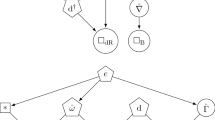Abstract
The Dirac operator arises naturally on\(\mathbb{S}^1 \times \mathbb{S}^3 \) from the connection on the Lie group U(1)×SU(2) and maps spacetime rays into rays in the Lie algebra. We construct both simple harmonic and pulse solutions to the neutrino equations on\(\mathbb{S}^1 \times \mathbb{S}^3 \), classified by helicity and holonomy, using this map. Helicity is interpreted as the internal part of the Noether charge that arises from translation invariance; it is topologically quantized in integral multiples of a constant g that converts a Lie-algebra phase shift into an action. The fundamental unit of helicity is associated with a full twist in u(1)×su(2) phase per global lightlike cycle. If we pass to the projective space ℝP1xℝP3, we get half-integral helicity.
Similar content being viewed by others
References
B. L. van der Waerden,Group Theory and Quantum Mechanics (Springer, New York, 1974).
J. J. Sakurai,Advanced Quantum Mechanics (Benjamin/Cummings, Menlo Park, California, 1973).
E. Wigner, “On unitary representations of the inhomogeneous Lorentz group,”Ann. Math. 40(1), 149–204 (1939).
V. Bargmann and E. P. Wigner, “Group theoretical discussion of relativistic wave equations,”Proc. Natl. Acad. Sci. USA 34, 211–223 (1948).
R. W. Bass and L. Witten, “Remarks on cosmological models,”Rev. Mod. Phys. 29, 452–453 (1957).
D. R. Brill and J. A. Wheeler, “Interaction of neutrinos and gravitational fields,”Rev. Mod. Phys. 29(3), 465–479 (1957).
L. H. Ryder,Quantum Field Theory (Cambridge University Press, Cambridge, 1985).
N. Hitchen, “Harmonic spinors,”Adv. Math. 14, 1–55 (1974).
W. L. Bade and H. Jehle, “An introduction to spinors,”Rev. Mod. Phys. 25(3), 714–728 (1953).
A. O. Barut and I. H. Duru, “Exact solutions of the Dirac equation in spatially flat Robertson-Walker space-times,”Phys. Rev. D 36(12), 3705–3711 (1987).
H. S. M. Coxeter,Non-Euclidean Geometry (University of Toronto Press, Toronto, Canada, 1942).
L. Infeld and B. L. van der Waerden,Sitzber. Preuss. Akad. Wiss., Phys.-Math. Kl. 380 (1933).
A. O. Barut,Electrodynamics and Classical Theory of Fields and Particles (Dover, New York, 1980).
R. Penrose and W. Rindler,Spinors and Space-Time, Volume 1: Two-Spinor Calculus and Relativistic Fields (Cambridge Monographs on Mathematical Physics) (Cambridge University Press, Cambridge, 1984).
T. Eguchi, P. B. Gilkey, and A. J. Hanson, “Gravitation, gauge theories and differential geometry,”Phys. Rep. 66(6), 1980.
N. D. Birrell and P. C. W. Davies,Quantum Fields in Curved Space (Cambridge University Press, Cambridge, 1982).
R. Abraham and J. E. Marsden,Foundations of Mechanics, 2nd edn. (Benjamin/Cummings, Reading, Massachusetts, 1978).
L. D. Landau and E. M. Lifshitz,The Classical Theory of Fields, 4th revised English edn. (Course of Theoretical Physics, Vol. 2) (Pergamon, New York, 1975).
R. Penrose and W. Rindler,Spinors and Space-Time, Volume 2: Spinor and Twistor Methods in Space-Time Geometry (Cambridge University Press, Cambridge, 1985).
D. H. Sattinger and O. L. Weaver,Lie Groups and Algebras with Applications to Physics, Geometry, and Mechanics (Applied Mathematical Sciences61) (Springer, New York, 1986).
C. Chevalley,Theory of Lie Groups (Princeton University Press, Princeton, 1946).
J. W. Milnor,Topology from the Differentiable Viewpoint (University of Virginia Press, Charlottesville, North Carolina, 1965).
Author information
Authors and Affiliations
Rights and permissions
About this article
Cite this article
Cohen, M.S. Quantization of helicity on a compact spacetime. Found Phys 25, 995–1028 (1995). https://doi.org/10.1007/BF02059523
Received:
Revised:
Issue Date:
DOI: https://doi.org/10.1007/BF02059523



